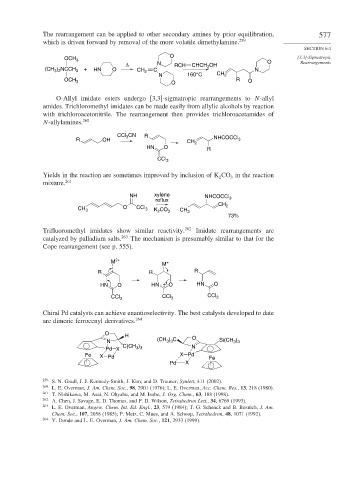Page 603 - Advanced Organic Chemistry Part B - Reactions & Synthesis
P. 603
The rearrangement can be applied to other secondary amines by prior equilibration, 577
which is driven forward by removal of the more volatile dimethylamine. 259
SECTION 6.4
OCH 3 O [3,3]-Sigmatropic
Δ N RCH CHCH 2 OH O Rearrangements
(CH ) NCCH 3 + HN O CH 2 C N
3 2
N 160°C CH 2
OCH 3 O R O
O-Allyl imidate esters undergo [3,3]-sigmatropic rearrangements to N-allyl
amides. Trichloromethyl imidates can be made easily from allylic alcohols by reaction
with trichloroacetonitrile. The rearrangement then provides trichloroacetamides of
N-allylamines. 260
CCl CN R
3
R OH CH 2 NHCOCCl 3
HN O R
CCl 3
Yields in the reaction are sometimes improved by inclusion of K CO in the reaction
3
2
mixture. 261
NH xylene NHCOCCl 3
reflux
CH
CH 3 O CCl 3 K CO 3 CH 3 2
2
73%
Trifluoromethyl imidates show similar reactivity. 262 Imidate rearrangements are
catalyzed by palladium salts. 263 The mechanism is presumably similar to that for the
Cope rearrangement (see p. 555).
M 2+ +
M
R R R
HN O HN + O HN O
CCl 3 CCl 3 CCl 3
Chiral Pd catalysts can achieve enantioselectivity. The best catalysts developed to date
are dimeric ferrocenyl derivatives. 264
O H
)
3 3
N (CH ) C O Si(CH 3 3
C(CH ) N
Pd X 3 3
Fe X Pd X Pd Fe
Pd X
259 S. N. Gradl, J. J. Kennedy-Smith, J. Kim, and D. Trauner, Synlett, 411 (2002).
260
L. E. Overman, J. Am. Chem. Soc., 98, 2901 (1976); L. E. Overman, Acc. Chem. Res., 13, 218 (1980).
261
T. Nishikawa, M. Asai, N. Ohyabu, and M. Isobe, J. Org. Chem., 63, 188 (1998).
262 A. Chen, J. Savage, E. D. Thomas, and P. D. Wilson, Tetrahedron Lett., 34, 6769 (1993).
263 L. E. Overman, Angew. Chem. Int. Ed. Engl., 23, 579 (1984); T. G. Schenck and B. Bosnich, J. Am.
Chem. Soc., 107, 2058 (1985); P. Metz, C. Mues, and A. Schoop, Tetrahedron, 48, 1071 (1992).
264
Y. Donde and L. E. Overman, J. Am. Chem. Soc., 121, 2933 (1999).

